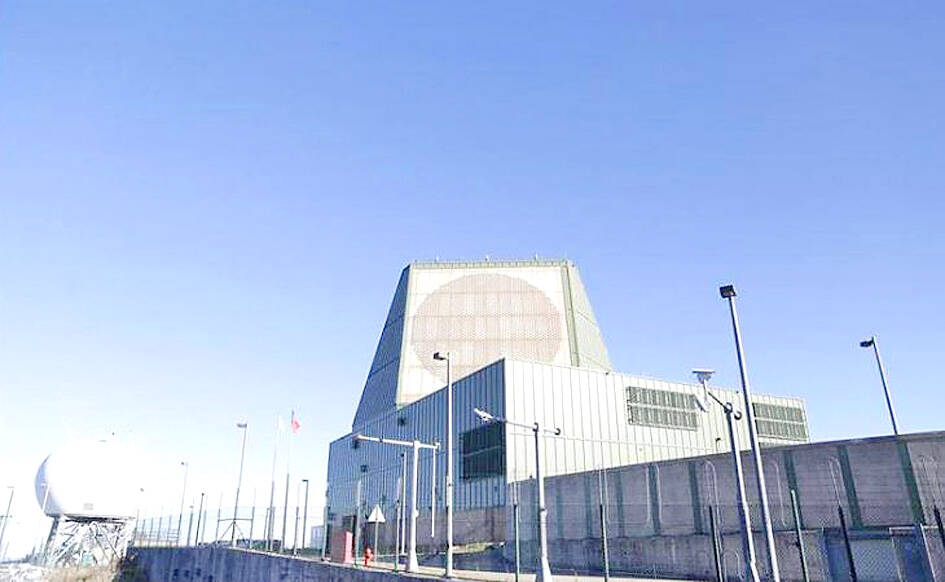Taiwan’s centerpiece of an air defense system, the AN/FPS-115 PAVE PAWS long-range radar in Hsinchu County’s Leshan (樂山), is expected to cost NT$2.39 billion (US$75.01 million) to maintain next year, the Ministry of National Defense’s budget for the next fiscal year showed.
The ultra-high-frequency radar deployed as a fixed installation has a reported maximum range of greater than 5,500km, enough to probe into China’s hinterland, Indochina and the South China Sea, sources said.
The system was operationally activated in February 2013.

Photo: Taipei Times file
The ministry allocated NT$5 million to install an identification system and NT$147 million to maintain the PAVE PAWS’ auxiliary systems in addition to the maintenance of the radar itself, the budget showed.
The radar maintenance budget is only this year’s portion of a much larger continuing technical support program linked to the system that would run over the next four years, it said.
When asked about the costs of the radar, a defense official with knowledge of the matter said on condition of anonymity that the PAVE PAWS system provides Taiwan with sophisticated and highly classified US technology.
US technicians perform the maintenance of proprietary technologies to ensure the system can operate effectively without compromising secrecy, they said, adding that a team of US engineers is stationed in Taiwan for this purpose.
Despite the high maintenance cost associated with it, operating the PAVE PAWS system is necessary for the nation to have the important capability of tracking Chinese missiles, they said.
The Chinese People’s Liberation Army’s recent military exercises, including those that involved firing missiles into Taiwan’s eastern seas, were monitored by the PAVE PAWS system, the official said.
The continuing technical support of the long-range radar is arranged with the US for five-year periods, with the first period starting in 2012, the second in 2017 and the third in last year.
The current technical support increment would cost the nation NT$16.6 billion.

Actor Darren Wang (王大陸) was questioned by prosecutors for allegedly orchestrating an attack on a taxi driver after he was allegedly driven on a longer than necessary route in a car he disliked. The questioning at the New Taipei City District Prosecutors’ Office was ongoing as of press time last night. Police have recommended charges of attempted murder. The legally embattled actor — known for his role in the coming-of-age film Our Times (我的少女時代) — is under a separate investigation for allegedly using fake medical documents to evade mandatory military service. According to local media reports, police said Wang earlier last year ordered a

CAUTION: Based on intelligence from the nation’s security agencies, MOFA has cautioned Taiwanese travelers about heightened safety risks in China-friendly countries The Ministry of Foreign Affairs (MOFA) yesterday urged Taiwanese to be aware of their safety when traveling abroad, especially in countries that are friendly to China. China in June last year issued 22 guidelines that allow its courts to try in absentia and sentence to death so-called “diehard” Taiwanese independence activists, even though Chinese courts have no jurisdiction in Taiwan. Late last month, a senior Chinese official gave closed-door instructions to state security units to implement the guidelines in countries friendly to China, a government memo and a senior Taiwan security official said, based on information gathered by Taiwan’s intelligence agency. The

President William Lai (賴清德) should protect Taiwan Semiconductor Manufacturing Co (TSMC), and stop supporting domestic strife and discord, former president Ma Ying-jeou (馬英九) wrote on Facebook yesterday. US President Donald Trump and TSMC on Monday jointly announced that the company would invest an additional US$100 billion over the next few years to expand its semiconductor manufacturing operations in the US. The TSMC plans have promoted concern in Taiwan that it would effectively lead to the chipmaking giant becoming Americanized. The Lai administration lacks tangible policies to address concerns that Taiwan might follow in Ukraine’s footsteps, Ma wrote. Instead, it seems to think it could

Taiwan Semiconductor Manufacturing Co (TSMC), the world’s largest contract chipmaker, said yesterday that it is looking to hire 8,000 people this year, at a time when the tech giant is expanding production capacity to maintain its lead over competitors. To attract talent, TSMC would launch a large-scale recruitment campaign on campuses across Taiwan, where a newly recruited engineer with a master’s degree could expect to receive an average salary of NT$2.2 million (US$60,912), which is much higher than the 2023 national average of NT$709,000 for those in the same category, according to government statistics. TSMC, which accounted for more than 60 percent